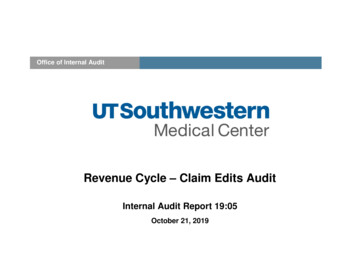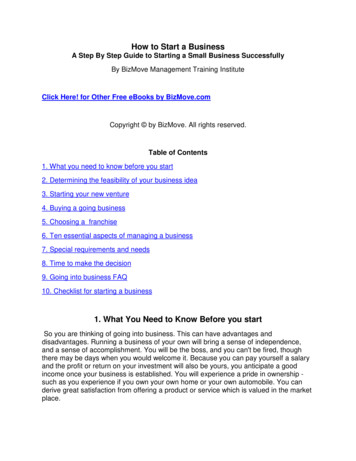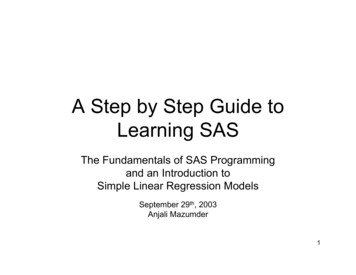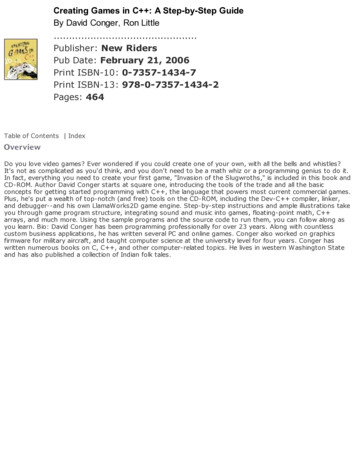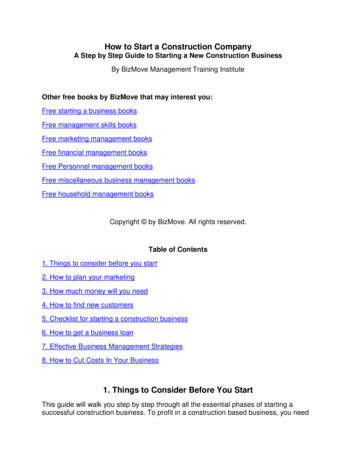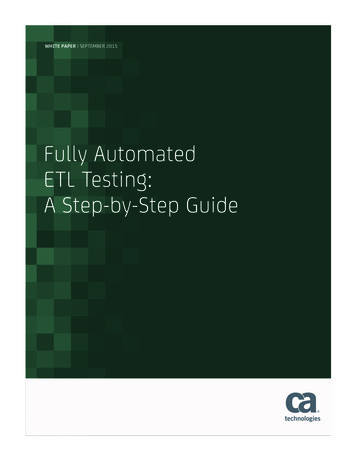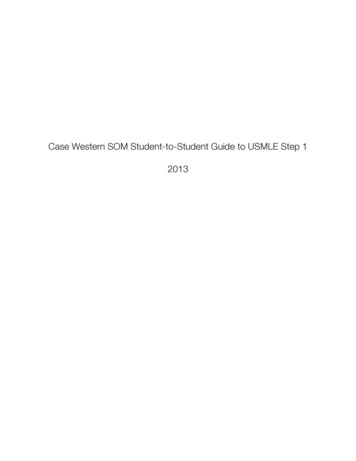
Transcription
Case Western SOM Student-to-Student Guide to USMLE Step 12013
How to Use This GuideThis guide was created from advice gathered by about a dozen students of the SOM Class of2015. They were chosen because they are dedicated, hard-working individuals who did well on thetest and want to pass on their experience to you. Specific students who were experienced with aparticular topic or resource were chosen to write reviews for that area. Therefore, the reviews donot reflect the collective opinion of the class of 2015 in general, but the individual opinion of peopleexperienced with that resource (the “experts”, so to speak).It is divided into roughly three sections. The first section is a collection of student reviews on thevarious resources used for board studying, ranging from Qbanks to test prep books. The secondsection offers some sample study plans used by students for board studying. The third section is acollection of advice on some of the more difficult questions you will face from now until the day ofthe exam, ranging from scheduling to tips on the day of the test.This guide is a way for those who have taken the test recently to transfer experience to you. It ismeant to shed light on the whole experience of preparing for Step 1 and to share insight and ideasthat you have not had yet. It should be an aide in creating your study plan for the boards and toquell any anxiety you have for the whole process. Good luck.1
Table of ContentsStudy Resources1.1-1.4-Qbanks .3-52.1-2.8-Comprehensive Study Guides 6-93.1-3.7-Study Resources by Subjects 10-15Sample Study Plans4.1 Wearn Method . .164.2 Robbins Method . .16-174.3 Satcher Method . . .18-19Section 3-General Advice5.1 Advice for Pre-Board Studying .20-225.2 Advice for Board Studying Period .22-245.3 Advice for Day of Exam .24-252
Qbanks1.1 xThe USMLERx Qbank is extensive and has very detailed, “nitty gritty” questions. By contrast,Uworld tends to have more general questions that are closer to the style of Step 1. It is notnecessary to complete the Rx Qbank and it is too ambitious to attempt to do it all in your boardstudying period because Uworld will be your Qbank at that time. However, the Rx Qbank is usefulfor preparing you to answer boards style questions, meaning thinking in the way that you need tofor Step 1 and answering a set of difficult questions under timed conditions. The Rx Qbank isprobably best used in tandem with studying after Block 4, because many questions are integrativeand you will not have the knowledge base to answer them prior to completing Block 4. It should beused as an assessment of your learning and to gauge how well you can apply that learning toBoards style exams. Put another way, it takes the information you’re learning in your blocks andpresent them in a question format similar to how the USMLE would do it. A good way to use itwould be to do 10-20 questions per day or spend an hour or two on a weekend testing materialthat you have recently learned. You will most likely forget many of the details when it is time tostudy for boards, but you will have at least seen common questions and that will make boardsprep easier.Bottom Line: 7/10Second Opinion: Given the reference pages to FA, this Qbank is best used in tandem to studyingFA for the first time. This is important because you might know WHAT information needs to becovered through FA, but you wouldn’t know HOW that information is presented in the USMLEunless you use a Qbank like USMLERx. The USMLERx does a pretty good job with accuratelyrepresenting the clinical presentations of each disease you’re likely to see in the USMLE. In reality,the actual USMLE tests more basic science than what USMLERx provides, but is more conceptualand less detail-oriented than the Kaplan Qbank.Rating: 8/101. 2 Kaplan 1/s1-qbank.htmlPros: 2200 Qbank questions 1 diagnostic test 2 simulated exams 3000 questions. I foundthe explanations to be good, comparable to UWorld answers, fairly long and detailed. Someanswers have additional video explanations done by Kaplan faculty, which I was skeptical about atfirst, but ended up finding them quite helpful. Questions provide First Aid page references acrossmultiple editions and Med Essentials (another Kaplan product) page references, which made FirstAid annotation much, much easier (but no page references for Kaplan Lecture Notes). Higherquality and quantity of heart sounds and videos of signs/symptoms than UWorld. Added bonus:iPhone/Android app support.Cons: More detail-oriented than UWorld and USMLERx; though one upside is that there's anoption to only choose the "Highest Yield questions" (still 1600 questions). As a result, somequestions can be more nit-picky than what you would be used to in UWorld (which has a more3
conceptual focus). Some questions are worded poorly, but I would say that's just a minority ofquestions. No option for feedback built into the system so you need to make an added effort toemail them if you want them to look at a particular question.If used during dedicated board study time as a second or third Qbank (in addition to UWorld), Ithink Kaplan is quite valuable. Its value will depend on how you structure your time and how manyquestion you plan to do per day. When crunched for time, only go through the 'Highest Yieldquestions', avoiding a lot of the more poorly worded / overly detailed questions that Qbank has.Looking back, I would have done a more thorough pass through Kaplan Qbank's Highest YieldOnly (or missed questions marked) alongside UWorld instead of going through UWorld 2x.Bottom Line: 8.5/10, I'm in the camp of the more unique questions you are exposed to, the better.I'm obviously biased towards Kaplan, but to each his own. Some of the questions werefrustrating/infuriating, but overall I was quite satisfied.Second Opinion: 8/10 In general, I would recommend getting two QBanks while studying for theStep 1, as you will run out of questions too quickly otherwise. Kaplan questions are an effectivetool for study and decently mimic questions on the board exam. However, the Kaplan questionsare more difficult and more detail-oriented than the USMLEWorld questions.1. 3 USMLE World Qbankhttp://www.usmleworld.com/purchase.aspxUWorld is hands down THE BEST Qbank out there. It very accurately mimics the medium-hardquestions of the actual test. The format is exactly the same as the real test, so it’s nice to befamiliarized with the strikeout, highlight, calculator, and lab value tools. The only caveat is that theanatomy and physiology sections were not as emphasized as compared to the real test or NBMEpractice tests. To fully utilize the power of this resource, do mixed, timed sets. In the beginning ofthe test study period, question sets can target specific organ systems. However, the problem that Irun into doing these targeted sets are 1) I unconsciously tie each question to the particular organsystem I’m working on (e.g. my DDX of a pt. with epigastric pain in a GI set would be limited to GIproblems, when in fact the pain could be cardiovascular, pulm, or MSK in nature) and 2) I forgetinformation from other organ systems. So with 2-3 weeks left, focus on doing mixed sets to buildstamina and train the mind to think about each question globally. UWorld now lets subscribersreset their account once so that all the questions are “unused”; take advantage of this feature toreset your account for mixed sets. Why? You want a “representative set” of mixed questions,which you wouldn’t get if for example you had exhausted all the cardio and GI questions doingtargeted sets.Specific Tip: take notes. What my partners and I found useful was to get about a dozen pieces ofpaper and assign an organ system/topic per piece of paper. For each question we got wrong, wewould write on the relevant piece of paper the set number and question number with a shortexplanation. Two weeks and 30 sets later, we could 1) easily find the UWorld explanations for anyparticular question we got wrong, 2) track topics we were weak in (it’s usually the ones with themost writing on them), and 3) in 30 minutes, we can quickly review all the stuff we got wrong.Bottom Line: 10/104
1.4 UWorld v. Kaplan v. USMLERxAhh, the age-old “Which Qbank is better?” question.there are lots of opinions about this: a quicksearch on SDN will reveal the consensus that UWorld is the best, but also best saved for last, as itmost mirrors Step 1, while both USMLERx and Kaplan are 'good'. From what I understand,USMLERx questions are easier than UWorld, and are more 'buzz-word' focused. I would sayKaplan is more on the UWorld end of the spectrum, where questions stems (and explanations) arelonger and don't always provide the buzzwords that immediately allow you to select the rightanswer. Kaplan questions are definitely as hard, if not harder than UWorld. As Kaplan does haveFirst Aid page references, it actually works fairly well with First Aid, considering much of what is inKaplan is not even touched in First Aid. The most common complaint I hear about Kaplan is that "ittests minutia", however I'll make the counter argument that the real Step 1 itself also tests minutia,and it's definitely not going to be all buzz-words. Furthermore, if the more detailed questionsbother you and you don't feel it's 'high yield', it's easy enough to filter them out or just skip them. Ican't say whether Rx or Kaplan is better, but if I were to do it again I would still pick Kaplan despiteits shortcomings as I found the more challenging questions to be most helpful in me learning newmaterial.Bottom line: 1) save enough time to go through UWorld 1.5-2 times at the end and if you have timebefore that, go ahead and get another QBank. 2) The strength of USMLERx and Kaplan is to teachyou specific “high yield” details for the USMLE (and the test is all about memorizing “high yield”details). So don’t worry about how high you score for these Qbanks or how many questions youget through. The real question you should ask yourself is: how much information will you retainwhen you finally move on to UWorld?5
Comprehensive Study Aids2.1 First es/dp/0071831428/ref sr 1 5?ie UTF8&qid 1383609957&sr 8-5&keywords first aidStrengths/Weaknesses: This is a very comprehensive text, meant to highlight all the importantcontents of the USMLE and dive into the most high-yield details. There is no section that isparticularly weak, but I have noticed that in general physiology and anatomy are not asemphasized as they are in the real test. Of course, the lack of images and histology in many of thepathology sections is also a weakness, although recent editions have been adding more and moreof that. Also, occasionally FA simply lists random factoids; treat these as reminders for you to coverparticular areas of knowledge with other sources. At a certain point towards the end of thestudying period, FA will not be detailed enough and you will start to crave other materials (butbefore you get ahead of yourself, you had better know FA cold before deciding to branch out).Use before study period: One of the most important uses of FA during the blocks is to bridge thegap between the Case curriculum and what you need to know for the boards. So even though thisadvice is trite, cover everything on FA for the particular organ system you’re studying in class; thereis no such thing as a “low yield” topic in FA. Also, it’s not enough that you understand theconcepts and took notes on them-- you literally need to memorize these things. In my experience,it’s better to memorize something, forget it, and re-memorize it rather than desperately trying tocram something in for the first time 4 weeks before your test. My advice: do some questions in aQbank, realize why you have to memorize these facts, and then memorize them. Don’t be lazy andthink “Oh I understand why I got it wrong”. No, memorize that key fact and own it.Use during study period: Read FA, take notes. Reread FA, retake notes on information you’rehaving trouble with. Memorization is key for FA. It is not meant to be read and understood, it ismeant to be committed to memory. For many, if not most, questions on UWorld and the USMLEtest, recall of key knowledge is necessary to get the question right and there is no way to “think”through these questions; you either know the information or you don’t. I’ve known people wholiterally take blank paper and attempt to rewrite whole pages from FA from memory, that’s howhigh yield this book is.Bottom Line: 10/10 First Aid and UWorld are the core curriculum and deserve the majority of yourattention. FA is not perfect and there will be questions on UWorld that go beyond the scope of FA.Study these questions but don’t freak out. It’s better to master the core material first and then gochasing those esoteric bits of information that might or might not show up on the real exam.2.2 UWorld QbankThis resource is so important it’s going to be included in this guide twice. UWorld is exquisitelyfine-tuned to the subtle details that are arbitrarily emphasized in the USMLE. The trouble peopleget into while doing UWorld is 1) They take 4 hours to go through 1 set of questions because theyread through every explanation. [No, you don’t need to go through questions you got right (unlessyou guessed), and no, you don’t need to read through the wrong answer explanations tounderstand the concept being tested. Exercise judgment.] and 2) They over-compensate by6
blowing through several sets in order to “meet their daily question quota”. Well, you don’t get extrapoints on your USMLE for going through 5000 questions. Just going through the motion of doingquestions is pointle
Bottom line: 1) save enough time to go through UWorld 1.5-2 times at the end and if you have time before that, go ahead and get another QBank. 2) The strength of USMLERx and Kaplan is to teach you specific “high yield” details for the USMLE (and the test is all about memorizing “high yield” details). So don’t worry about how high you .

